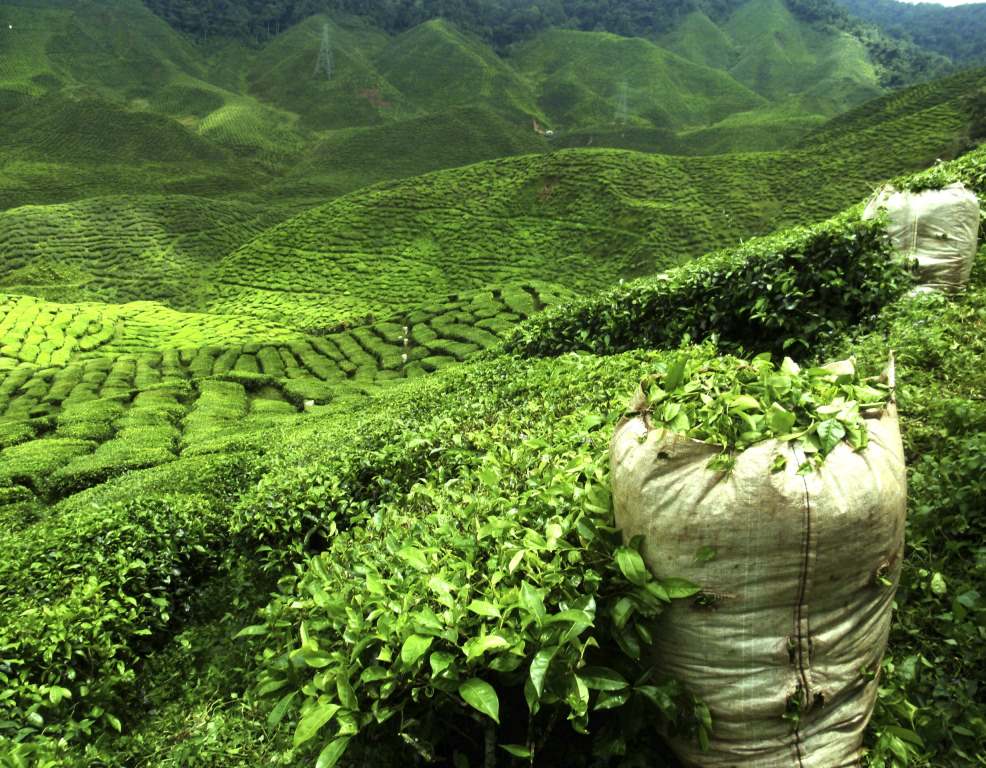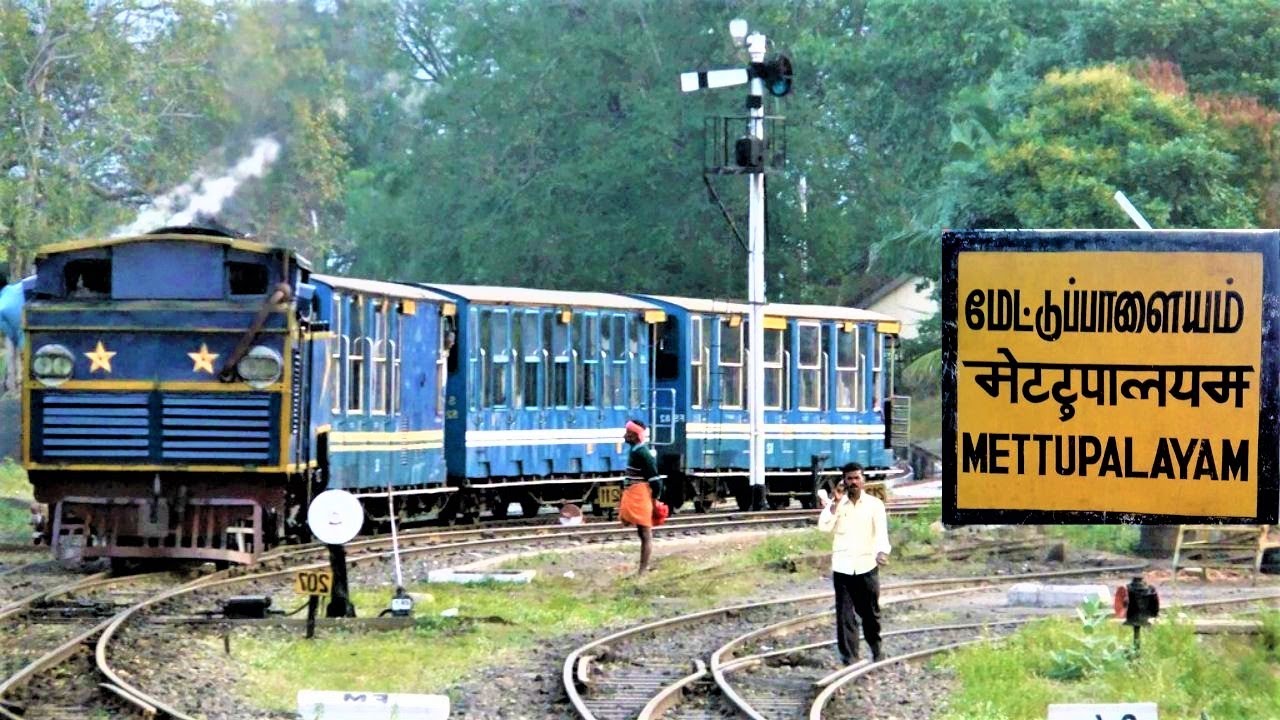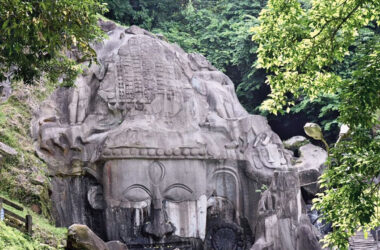Tea Plantations – Indians love a good cup of tea (chai) and India is one of the largest tea growers in the world. However, over 70 percent of it is consumed by Indians themselves. The production of tea really took off during the days of British rule in India, when large tracts of land were converted for mass tea production.
Indians love a good cup of tea (chai) and India is one of the largest tea growers in the world. However, over 70 percent of it is consumed by Indians themselves. The production of tea really took off during the days of British rule in India, when large tracts of land were converted for mass tea production. If you’re a tea lover, don’t miss visiting these places where you’ll find the best Indian tea plantations and tea. You can even stay on a tea estate and tour the tea factories.
Darjeeling, West Bengal
:max_bytes(150000):strip_icc():format(webp)/GettyImages-503909121-5a31ee719e94270037094556.jpg)
ADDRESS – Lebong Cart Rd, Chauk Bazaar, Near, Darjeeling, West Bengal 734101, India PHONE+91 80177 00700
Darjeeling, as well as being one of India’s most popular hill stations, is surrounded by tea plantations that produce prized light-colored, floral-smelling tea. Around 25 percent of India’s total tea output comes from Darjeeling.
Where to Go and Stay:
- The Happy Valley Tea Estate is located just north of town and offers the only guided tea factory tour in Darjeeling. The estate grows some of the finest tea in the region and has a long history. It was established by an Englishman in 1850, later taken over by an Indian aristocrat from Kolkata, abandoned and closed in 2005, and acquired by the Ambootia Tea Group in March 2007. Guided tours are conducted from 9:30 a.m. to 4:30 p.m. daily.
- Elegant Glenburn Tea Estate, about an hour northeast of Darjeeling, provides an unforgettable gastronomical experience. It’s Burra Bungalow was home to four generations of planters and has four guest rooms. There are another four rooms in a separate bungalow.
- Closer to Darjeeling in the Lebong Valley, Ging Tea House was built in 1864 and has been tastefully restored with six guest suites. Full-day tea experiences are offered, starting with tea in bed.
- Tumsong Chiabari Tea Estate, near Ghoom, belongs to the Chamong Group. The tea estate manager’s bungalow has been converted into an intimate property with four guest rooms. Bespoke packages of various lengths are offered. It’s ideal for birdwatchers. On a clear day, you can see all the way to Mount Kanchenjunga.
- The more modern Chamong Chiabari is another property belonging to the Chamong Group. This serene property is about an hour southwest of Darjeeling town and has nine guest rooms.
- Singtom Tea Resort, part of Darjeeling’s oldest Steinthal Tea Estate, is more reasonably priced and conveniently only 20 minutes from Darjeeling town. There are 1,600 acres of private tea gardens to explore!
- Makaibari Tea Estate, about an hour south of Darjeeling near Kurseong, offers homestay accommodations with local villagers. You can join them in tea plucking in the morning.
- Further south, two hours from Darjeeling and only 15 minutes from Bagdogra Airport, Nuxalbari Tea Estate is noteworthy for being the first large tea estate in India to produce “Certified Elephant Friendly Tea”. It’s also owned and operated by women. Tours of the estate are offered and tea is for sale.
When to Go: March to November for tea plucking, but the monsoon season from June to September is best avoided.
Assam, Northeast India
:max_bytes(150000):strip_icc():format(webp)/GettyImages-135558983-583dbc4e3df78c6f6a1f1ead.jpg)
ADDRESS – Gatoonga Tea Estate, Jorhat, Assam 785616, India PHONE+91 94355 14177
Assam, located in India’s remote northeast, is the largest tea-producing region in the country. Mostly grown in the Brahmaputra Valley, malty Assamese tea is brightly colored. Jorhat, in the central part of the valley, is often referred to as the “Tea Capital of the World”.
Where to Go and Stay:
- Stay at Banyan Grove on Gatoonga Tea Estate, near Jorhat. Built more than 100 years ago, it has a colonial style and seven guest rooms. You’ll be able to get a feel for what it’s like to live on a tea estate, as well as visit the factory and see how tea is made.
- Thengal Manor heritage hotel is another option in Jorhat.
- Alternatively, Wild Mahseer offers newly refurbished historic tea planter bungalows on the banks of the Brahmaputra River amidst Addabarie Tea Estate, near Tezpur in Assam.
Take a Tour: The Greener Pastures offers tea tours to Assam. NE Routes also conducts a comprehensive five-night tea tour with plantation stays.
When to Go: Mid-May to June end, for the best tea. Tea production continues until early December, but the quality of the tea steadily decreases. A Tea Festival is held in Jorhat every November.
Munnar, Kerala
:max_bytes(150000):strip_icc():format(webp)/173650641-56a3bfee5f9b58b7d0d3972e.jpg)
ADDRESS – KDHP House, NH 49, Nullatanni, Munnar, Kerala 685612, IndiaPHONE+91 4868 255 000
As you enter Munnar, a popular hill station in Kerala, you’ll be greeted by miles upon miles of lush tea plantations. Once owned by Tata, the largest tea manufacturing company in India, they’ve now been sold to employees.
Where to Go and Stay:
- Head to India’s first Tea Museum at Nallathanni Estate to take a fascinating look at the history of tea production in Munnar. It’s open daily, except Mondays, from 10 a.m. to 5 p.m. The cost is 125 rupees for adults.
- The Tea Harvester is a peaceful boutique resort surrounded by tea plantations.
- Dream Catcher Plantation Resort (with four stunning treehouses nestled into the tea plantations) and Gruenberg Tea Plantation Haus are also recommended.
- If staying on a tea plantation isn’t a must for you, Windermere Estate offers an exceptional experience. This outstanding heritage property consists of an original Planters Bungalow and 18 additional cottages on a cardamom plantation. It also has its own private lookout, atop a gigantic boulder.
When to Go: The tourist season is from August to May, although winters are very cold during December and January.
Kolukkumalai, Tamil Nadu
:max_bytes(150000):strip_icc():format(webp)/GettyImages-497520793-5a31d15b47c266003610d51d.jpg)
ADDRESS – Moolakadai, Munnar, Kerala 685612, India WEB Visit website
Just across the border from Kerala, at 8,000 feet above sea level, Kolukkumalai Tea Estate is perhaps the highest tea plantation in the world. The tea grown there is known to have a unique aroma and taste because of the high altitude. Although it’s located only about 20 miles (32 kilometers) from Munnar town, it takes around 2 hours to reach this isolated destination via Suryanelli in Kerala’s Idukki district due to the rugged terrain. The final part of the journey can only be undertaken by jeep. It’s a Teapicturesque drive though. The tea estate was founded by the British in the early 1900s, and its factory still uses the original orthodox method of tea processing. It’s possible to visit it on a day trip. However, for the best experience, stay at least one night on the property in the guesthouse or mountain hut.
Nilgiri Mountains, Tamil Nadu
:max_bytes(150000):strip_icc():format(webp)/83518754-56a3bfef5f9b58b7d0d39732.jpg)
ADDRESS Alwarpet, Coonoor, Tamil Nadu 643103, India PHONE+91 423 223 1811WEB Visit website
The mountainous Nilgiri district of Tamil Nadu, in south India, is known for its distinctive dark and intensely aromatic tea. Tea has been grown there for more than 100 years and is the most important industry in the region.
Where to Go and Stay:
- Coonoor is the best place to discover Nilgiri tea, as that’s where it was initially growing in the 19th century. Start at the Highfield Tea Factory, near Sim’s Park (or if you wish, Homedale is a much quieter option).
- Participate in one of the gourmet tea tasting experiences conducted by local tea industry pioneer, Tranqulitea, on their tea estate. You’ll get to sample a wide range of teas and learn how they’re made. Plantation tours and accommodations in plantation bungalows are also offered.
- Otherwise, stay in Coonoor at the delightful Tea Nest on Singara Tea Estate.
- Go there on the renowned Nilgiri Mountain Railway toy train.
- If you really want to get away from it all, O’land Plantation Stay is recommended. It’s about 45 minutes south of Coonoor.
Take a Tour: Breakaway offers this Blue Mountains and High Tea trip from Coimbatore to Coonoor and back. Your host, a tea planter, will share his knowledge with you. You’ll also get to visit a farm stay that makes cheese.
When to Go: Tea is produced throughout the year in Nilgiri. However, the best teas are produced during the cooler winter months (late November to mid-February).
Wayanad, Kerala
:max_bytes(150000):strip_icc():format(webp)/GettyImages-85325910-59004c885f9b581d59545b22.jpg)
ADDRESS Wayanad, Kerala 670644, India WEB Visit website
Wayanad, a lush mountainous agricultural area of Kerala, also produces a significant amount of tea (in addition to coffee and spices). Most of the tea plantations are located south of Kalpetta, in Vythiti and Meppadi. The road to Chembra Peak will take you through a private estate, which is worth a look.
Where to Go and Stay:
- Parisons Plantation Experiences is a serene property that has two luxuriously remodeled bungalows with a total of 10 bedrooms. It’s situated on a 4,025-acre tea estate with a 200-year-old history. Activities include tea tours, visits to tea factories, trekking on various tea trails, and afternoons at the Planters Club.
- Tea Terrace has attractive cottages set amid a tea plantation in Vythiri.
- Tea Route Homestay is popular at Meppadi.
- Wayanad Tea Drops has a two-bedroom cottage on the sprawling Chellotte Tea Estate in Chundale. It’s ideal for families and friends.
- Priyadarshini Tea Environs (Mananthavady Tribal Plantation Corporative Society) is a community tourism initiative. The estate has a tea factory, tea museum, accommodations, and activities for tourists.
When to Go: September through to April, to avoid the monsoon rain.
Palampur, Himachal Pradesh
:max_bytes(150000):strip_icc():format(webp)/GettyImages-521913088-59004f5a5f9b581d595ad50a.jpg)
ADDRESS – National Highway 20, Palampur, Himachal Pradesh 176061, India
Tea was introduced to Palampur, about an hour from Dharamsala in the Kangra Valley of Himachal Pradesh, in the mid-19th century by the Superintendent of Botanical Gardens in Peshawar, Doctor Jameson.
Where to Go and Stay:
- Palampur Cooperative Tea Factory welcomes visitors and offers factory tours.
- Wah Tea Estate is the northeast working tea estate in the Kangra Valley. It’s been in business since 1857 and survived the earthquake in 1905, which seriously disrupted tea cultivation in the area. The tea produced there is organic and 100 percent pesticide-free.
- Stay at The Lodge at Wah, a new eco-friendly boutique homestay on the property. It has eight rooms in three gorgeous, rustic cottages. Tea plantation and factory tours, and tea tastings are provided to guests.
- Other recommended options on tea estates in Palampur are Country Cottage Tea Garden Resort and Norwood Green.
When to Go: March to June and mid-September to November, for the best weather. Tea is plucked between April and October.
Previous article – Toy Train – Ride the Nilgiri Mountain Railway
Frequently Asked Questions About
Q. Which is the largest tea garden in India?
A – Monabari Tea Estate in Vishwanath district of Assam is the largest tea estate in Asia.
Q. Where is the tea garden in India?
A – The major tea-producing states in India are Assam, West Bengal, Tamil Nadu, Tripura, Arunachal Pradesh, Karnataka, Sikkim, Nagaland, Uttarakhand, Manipur, Mizoram, and Meghalaya.
Q. Which city in India is famous for tea?
A – Jorhat is known as the tea capital of the world and this small town has been the main center of tea cultivation in the state. A trip to Assam is certainly incomplete without visiting a tea garden and nearby factory.
Q. Which state is known as the tea garden of India?
A – The state of Assam is known as the tea garden of India. The collective yield of tea gardens is more than 1.5 million pounds of tea each year. Assamese tea is grown mainly in the Brahmaputra valley and is brightly colored. Located in the central part of the valley, Jorhat is often referred to as the “Tea Capital of the World”.
Q. Which state is the largest producer of tea?
A – Assam is the largest tea-producing state in India.
Q. Which is the tea capital of India?
A – Located in the southern part of the Eastern Himalayas in Assam. It is bordered by the states of Arunachal Pradesh, Nagaland, Manipur, Mizoram, Meghalaya, Tripura, and West Bengal. The state shares its borders with two countries, Bhutan and Bangladesh.
Q. Which city is famous for tea plantations?
A – Darjeeling, West Bengal. Darjeeling, as well as being one of the most popular hill stations in India, is surrounded by tea gardens that produce the prized light-colored, floral-smelling tea. Darjeeling accounts for about 25 percent of India’s total tea production.
Q. Who started tea gardens in India?
A – In 1788, The Royal Society of Arts began considering the idea of planting saplings from China. Then, in 1824, tea plants were discovered in Assam by Robert Bruce and Maniram Dewan. The tea gardens later spread throughout Assam and Darjeeling.









